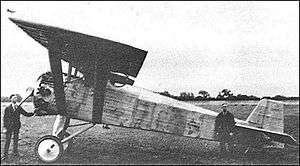Vickers Wibault
| Type 121 | |
|---|---|
 | |
| Role | Fighter |
| Manufacturer | Vickers |
| First flight | 1926 |
| Introduction | 1926 |
| Retired | 1934 |
| Primary user | Chile |
| Number built | 26 |
| Developed from | Wibault 7 |
The Vickers Type 121 Wibault Scout was a British fighter built by Vickers in the 1920s. It was a licensed version of the French Wibault 7 aircraft, with 26 being sold to Chile in 1926, where they served until 1934.
Design and development
Vickers set up a partnership with the French aircraft manufacturer, Société des Avions Michel Wibault to exploit the patented system of all-metal construction developed by Michel Wibault. This used corrugated light alloy skin panels, and made for easy maintenance and inspection.[1] As part of this partnership, Vickers placed an order with Wibault for a single Wibault 7, re-engined with a Bristol Jupiter VI radial engine, to act as a prototype for potential licensed production. The Wibault 7, and therefore the Vickers licensed copy, were single-engine high-wing parasol monoplanes.
The prototype, which differed from the standard Wibault 7 by having a new undercarriage and British instruments, was delivered to Britain in February 1926[2] and was later fitted by Vickers with strengthened wing struts. The durability of the aircraft's all-metal structure, together with promised good altitude performance, attracted the attention of the Chilean Military Air Service, which, after evaluating the prototype, placed an order for 26 aircraft, known as the Vickers Type 121, or Vickers-Wibault Scout.[3]
The first Vickers built Type 121 flew at the end of June 1926, but crashed following an inverted spin on its first flight. This was found to be due to problems with the aircraft's centre of gravity, which were resolved by modifying the tailplane.[4]
Operational history
The first Type 121s were delivered to Chile in November 1926, partly equipping the Groupo Mixto de Aviación 1, with deliveries continuing until October 1927.[2] Several were lost in accidents, with at least one losing its wing in flight,[2] but it remained in service when the Chilean Air Force was formed from the air components of the Chilean Army and Navy, finally being retired in 1934.[2]
Operators
Specifications (Type 121)
Data from The British Fighter since 1912 [4]
General characteristics
- Crew: one
- Length: 23 ft 8 in (7.22 m)
- Wingspan: 36 ft 1 in (m)
- Height: 11 ft 6 in (3.5 m)
- Wing area: 237 ft² (22.0 m²)
- Empty weight: 1,920 lb (873 kg)
- Loaded weight: 2,970 lb (1,350 kg)
- Powerplant: 1 × Bristol Jupiter VI nine cylinder radial, 455 hp (339 kW)
Performance
- Maximum speed: 125 kn (144 mph, 232 km/h) at 15,000 ft (4,600 m)
- Range: 261 nmi (300 mi, 483 km)
- Service ceiling: 23,000 ft (7,010 m)
- Wing loading: 12.5 lb/ft² (61.4 kg/m²)
- Power/mass: 0.15 hp/lb (0.25 kW/kg)
- Climb to 10,000 ft (3,050 m): 7 min 40 sec
Armament
- Guns: 2 × .303 in (7.7 mm) Vickers machine guns
See also
- Related development
References
Notes
Bibliography
- Andrews, E.N. and Morgan, E.B. Vickers Aircraft Since 1908, Second edition. London: Putnam, 1988. ISBN 0-85177-815-1.
- Green, William and Swanborough, Gordon. The Complete Book of Fighters. New York: Smithmark, 1994. ISBN 0-8317-3939-8.
- Mason, Francis K. The British Fighter since 1912. Annapolis, Maryland: Naval Institute Press, 1992. ISBN 1-55750-082-7.
External links
![]() Media related to Vickers Wibault at Wikimedia Commons
Media related to Vickers Wibault at Wikimedia Commons